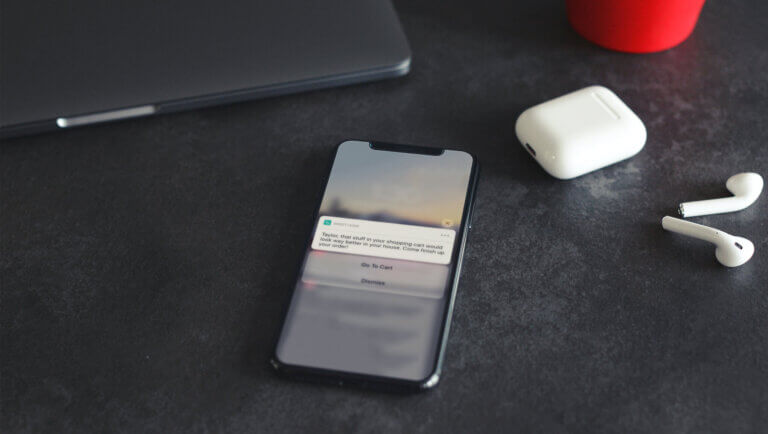
Mobile App Marketing: Choosing the Right Channels

AJ Park Sr. Content Marketing Manager

Share to my network
In this article
Categories
Book a meeting
Connect with our team of experts to discuss your conversion and loyalty goals, and how we can help you achieve them faster.
Get a demoHave you ever uninstalled an app from your phone because you were getting too many push notifications? Or wondered why your flight information is popping up as a text message, rather than in your mobile wallet?
Bad messaging channel choices, that’s why. Mobile devices offer a huge number of different ways to connect with your users and customers. Each channel is best suited to convey different types of messages. It’s imperative to choose the right one for the message you want to send.
No App? No Problem.
Even without an app, you have several options for getting messages to your users on their mobile devices.
SMS
Text messaging is the original mobile channel. With SMS and MMS, you can reach anyone who’s given you their number, and your messages arrive instantly. Limitations with this channel include your control over the message’s aesthetic and how interactive your message can be. But all you need is a phone number to get started.
Text is best used for simple, urgent messages, particularly transactional ones, such as flight status updates. (But only if you don’t have an app!) They’re often used for discounts and other infrequent announcements as well, but you’ll have much more success with messages sent through an installed app.
Website
Marketers often don’t think of their website or web app as a communication channel, but it is. Since you have to wait for your users to come to you, it is much more passive channel, making it tricky to provide users with timely updates. You also lose a lot of context, such as your visitor’s exact location. But websites do allow you to closely track what your user is doing, and let them immediately take many different types of actions.
Your website is best used for messages that aren’t urgent, and that are meant to be acted on while your user is visiting your site. For example, a month-long sale is useful to promote through your site, since many of your regular visitors will see it and you can link them directly to items on sale. Timely updates such as shipping notifications are much less useful to send through your site, since your user won’t see them immediately. As another example, it’s hard to re-engage dormant users on your site, although it is a great channel for acquiring new ones.
Mobile Wallet
Apple and Google are constantly adding features to digital wallet passes. It’s appropriate to think of a mobile wallet pass as a lightweight version of an app. Passes are easy to distribute, easy for a user to add and can be easily branded so that users recognize and remember your pass.
They can pop up at when the user is near locations where the pass would be most useful, for example, near your store or venue. And, they can be effortlessly updated with new information as it becomes necessary.
Use a digital wallet pass any time you would otherwise hand your user a piece of paper or plastic. Tickets, loyalty cards, payment cards, and coupons are all great uses for digital wallet passes. Digital wallets are less ideal for specific messages about product updates and transactional communications.
For more ideas on connecting with your customers using digital wallets, take a look at our Mobile Wallet Idea Book.
Got an App? Great!
Of course, having an app gives you many more options when it comes to reaching potential customers.
Push Notifications
If you get a user to install your app, you can send a push notification at any time — and even within a specific window of time. What’s nice about this channel is that your user doesn’t even have to be in the app to see it, it will pop to their notification screen. They’re easily branded, and you can even specify actions or destinations for the user to take. With a single tap you can send them where you want them to go, within your app or elsewhere.
Push notifications are great for delivering concise, brief real-time updates (like sports scores, notifications and news), as well as for getting a user to take a specific action, such as taking advantage of a special promotion. However, they only reach people who have opted-in, which is usually less than half of your users. They’re also high stakes — users will notice immediately if you send irrelevant content, and may revoke push access off for your app on the spot, or worse, uninstall it.
In-App Messaging
In-app messages are similar to push notifications, but they’re delivered to your users while they are active in your app. You can put real-time updates in them, and, unlike push notifications, they don’t require opt-in in order to be received, allowing you to reach 100% of your audience.
In-app messaging is a great complement to push notifications for users who haven’t opted in, and can be used to send similar, highly-targeted messages, such as real-time information that’s relevant within the context of your app. The use cases for in-app messaging provide nearly endless possibilities for connecting with your customers. Let us give you a few ideas to jumpstart the process!
Left: an in-app message from Crystal. Right: The Redbox app’s message center.
Message Centers
Message centers exist in the background of your app, making it a more passive channel, yet still one that provides value. The message center archives messages that have been sent to your users in the past and stores them in an inbox. This is a great channel for storing things that don’t require immediate action, but that a user might find value in and want to return to later for reference. While less active, the power of a message center is that it reaches your entire app audience, including those who may have opted out of other channels such as push messaging.
Mobile Messaging Content
No matter what channel you use, your user’s attention is a precious resource, and you have to make sure that what you’re sending is valuable to them. Personalization is key to ensuring value to each individual. Answer these questions before you use any of these channels to ensure that you are optimizing your content for your users:
“What is the purpose of this message?”
What action do you want the user to take when they receive it? Figuring this out will make it easier to decide on whether you need a channel with interactivity; it will also help you figure out how truly urgent your message actually is, and how to measure its success. Is there a call to action, or is this purely for brand awareness?
“What context does this message need to be relevant?”
Mobile messaging is all about context: time, location user preferences. Deciding what context is truly important to your user will help you pick the best channel. For example, if something matters in real-time, you should use push. If it matters less when the user acts on it, you could try message center.
“Will my user care?”
First and foremost, whether what you’re sending is useful. If you’re Twitter, it might be OK to send 20 push notifications a day, if you know your user wants to keep a close eye on their followers. But if you’re a mobile game, maybe you shouldn’t even send one push notification a week, because your user is a casual gamer who doesn’t care about new features and doesn’t want them interrupting their day. If you focus on delivering what your user wants, you’ll have to worry a lot less about everything else.
Next Steps
As a mobile marketer, you’ve got lots of channels to choose from. We haven’t even touched on emerging channels, such as chatbots and wearables, which will play an increasingly larger role in delivering useful content. The key with any channel is to match the characteristics of the message to the medium. And don’t forget to listen to your users, too — if you pay attention to their responses and preferences, they’ll tell you how and what they want delivered.
Take a look at this guide compiled by our digital strategists to get even more best practices and insights we’ve learned from cross-industry engagement results.

